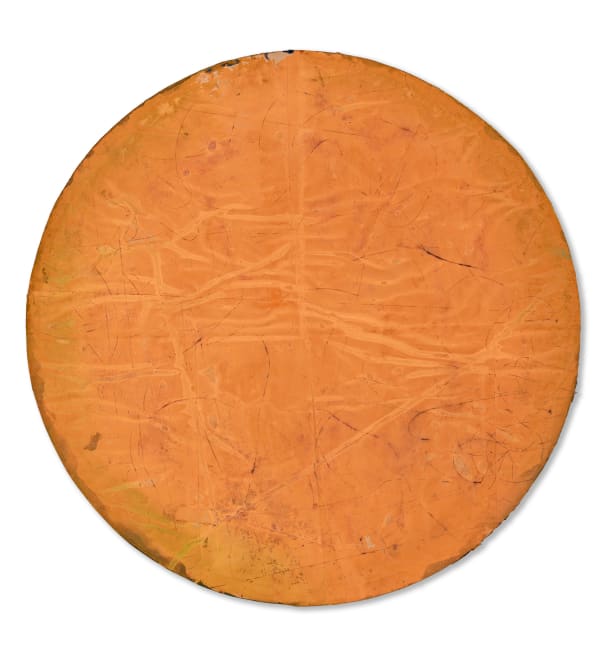Manny Farber | Works on Paper 1968-1980
Quint Gallery is pleased to present a small survey of Manny Farber’s works on paper made between New York and San Diego from 1968-1980. This series, which the painter/film critic began in the last years before moving to Southern California, was a departure from his Expressionist abstractions and wooden constructions and a predecessor to his later tabletop compositions of everyday objects.
In 1967, Farber began to develop the idea of creating his paintings through the lens of sculpture, while loosely working within the terrain of both action painting and geometric abstraction. Farber would cut large sheets of Kraft paper into trapezoids, ovals, and other geometric shapes with sharp corners and rounded edges. After overlapping and doubling edges, cutting and crafting seams, Farber incrementally strengthened the flimsy construction paper by pouring paint from above, often alternating complementary colors on either side. In these works, front and back become interchangeable; as pools form around folds and slits on one side, the other reveals an inverse, yet unique form of its own. This period may also be seen in light of the Color Field tradition, though Farber rejected the popularity of highly saturated, artificial colors in favor of muted, organic chromatic choices which bled through these thin but intricately layered papers. Farber’s process created channels and pockets for poured pigment to travel through and settle into, allowing the surface to dictate the gesture.
In addition, there will be several narrative works on paper during Farber’s early years teaching both visual art and film, and the beginning of his enduring series of tabletop compositions. These works, in the Auteurs, American Candy, and Stationery series, were named for directors and films of the time, and depicted candy sold in movie theaters, cigarettes, and stationery used for his film criticism.
Born in Douglas, Arizona in 1917, Farber began painting in the 1930s. Before joining the faculty of the University of California, San Diego Visual Arts Department in 1970, he was a film critic in New York, writing for the New Republic, the Nation and Artforum. He retired from teaching in 1987 and continued painting at his studio in Leucadia, California until his passing in 2008. Farber received the National Endowment for the Humanities, Fellowship for Independent Study in 1977-78 and the Guggenheim Fellowship in 1978-79. His work is included in the collections of the Museum of Contemporary Art, Los Angeles, the Solomon R. Guggenheim Museum, New York, the Whitney Museum of American Art, New York, Museum of Contemporary Art, San Diego, and the Museum of Fine Arts, Boston among others. In 2018, the Museum of Contemporary Art organized One Day at a Time: Manny Farber and Termite Art, an exhibition inspired by Farber and his legendary essay “White Elephant Art vs. Termite Art” (1962), which included more than 100 works of painting, sculpture, photography, film, video, and sound dating from the 1950s to the present.
-
 Manny Farber, Untitled, c. 1967 - 1975
Manny Farber, Untitled, c. 1967 - 1975 -
 Manny Farber, Untitled, c. 1967 - 1975
Manny Farber, Untitled, c. 1967 - 1975 -
 Manny Farber, Untitled, c. 1967 - 1975
Manny Farber, Untitled, c. 1967 - 1975 -
 Manny Farber, Untitled, c. 1967 - 1975
Manny Farber, Untitled, c. 1967 - 1975 -
 Manny Farber, Untitled, c. 1967 - 1975
Manny Farber, Untitled, c. 1967 - 1975 -
 Manny Farber, Untitled, c. 1967 - 1975
Manny Farber, Untitled, c. 1967 - 1975 -
 Manny Farber, Untitled, c. 1967 - 1975
Manny Farber, Untitled, c. 1967 - 1975 -
 Manny Farber, Untitled, c. 1967 - 1975
Manny Farber, Untitled, c. 1967 - 1975











